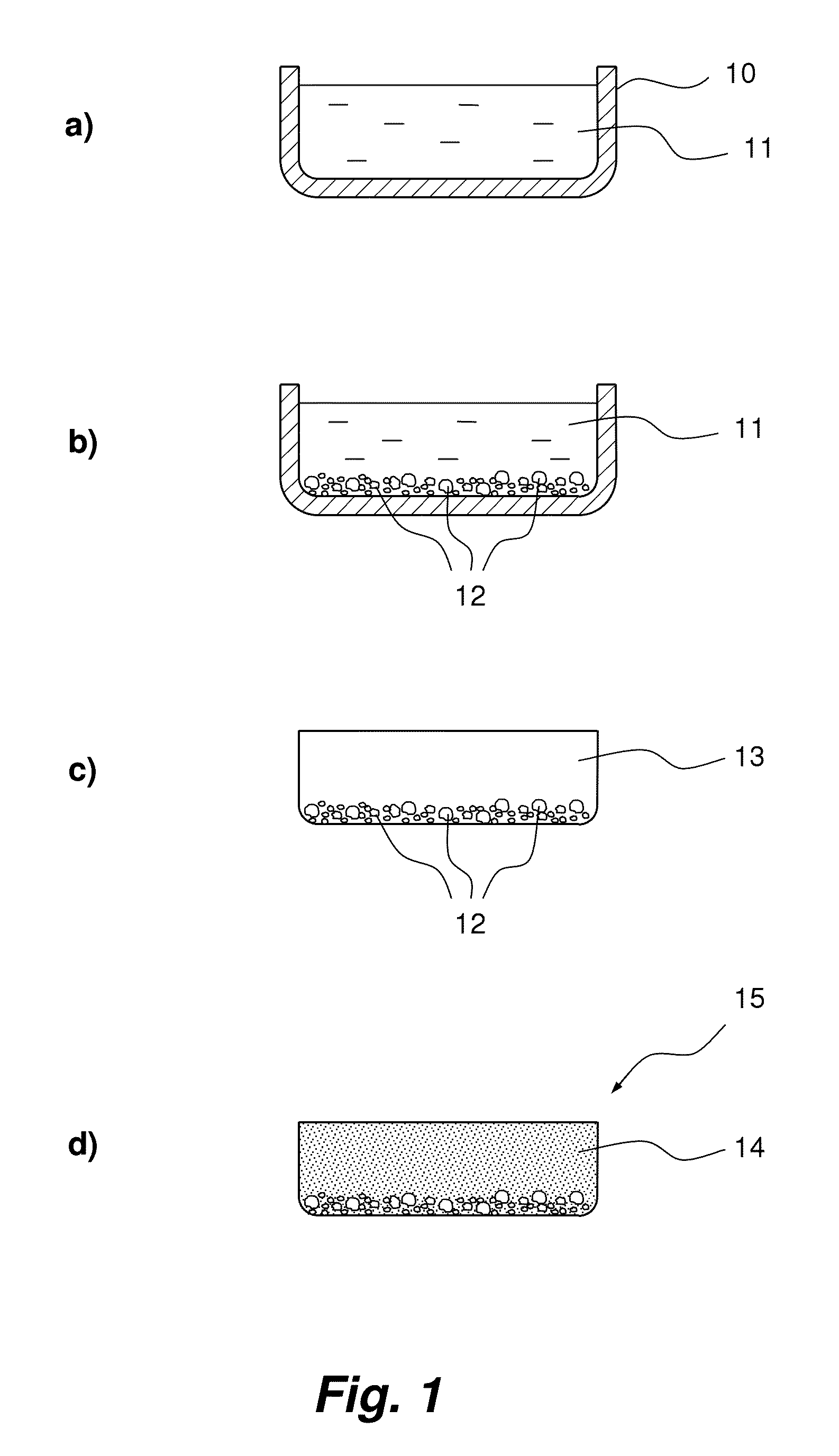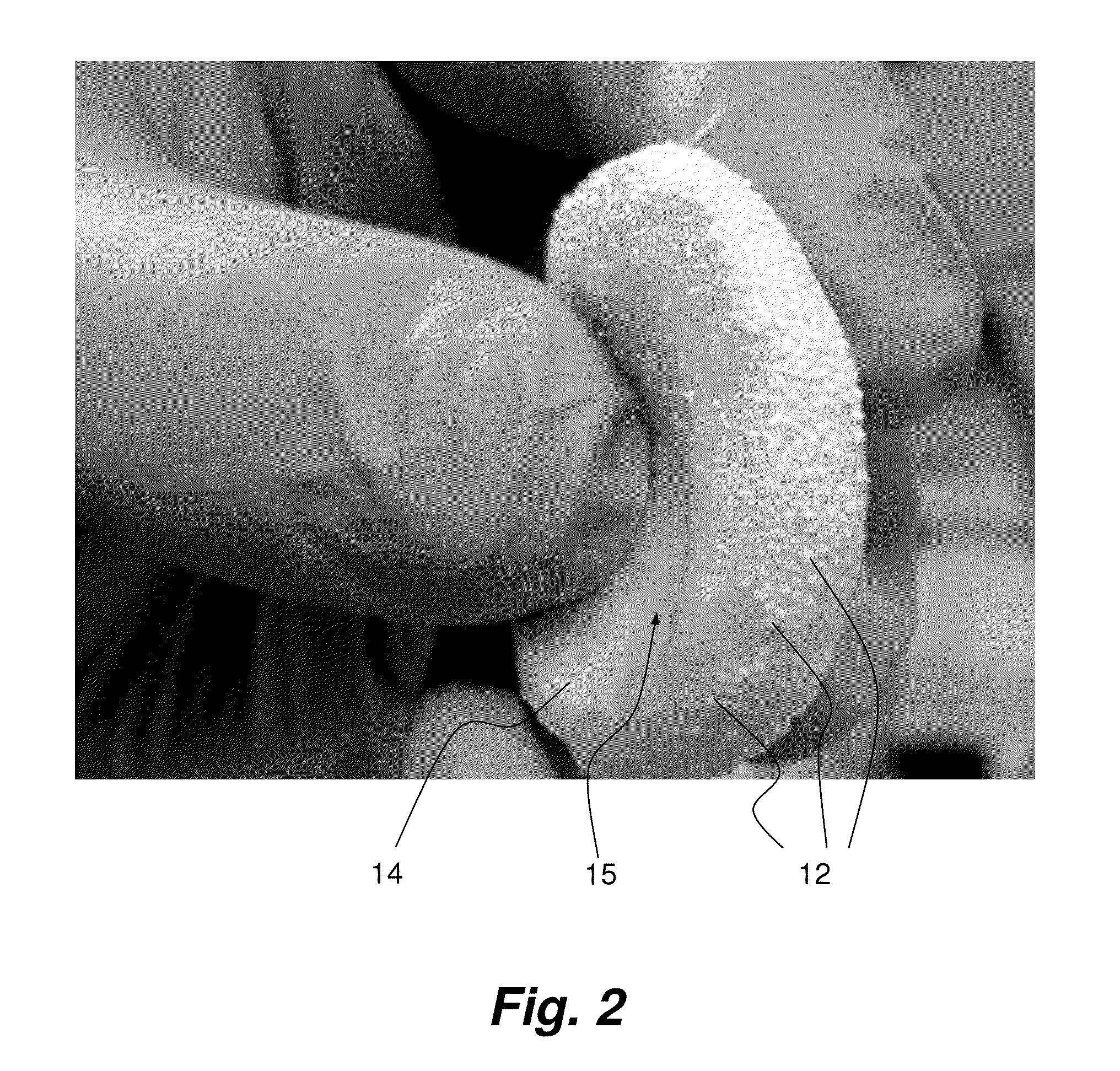Method for preparing biocompatible and biodegradable biomaterials based on collagen and granules of hydroxyapatite/β-tricalcium phosphate for use in surgery, and biomaterials thus obtained
a biocompatible and biodegradable technology, applied in the field of biomaterial preparation, can solve the problems of poor degradability of ha by body fluids, inability to withstand in vivo absorption, fragile and thus not flexible,
- Summary
- Abstract
- Description
- Claims
- Application Information
AI Technical Summary
Problems solved by technology
Method used
Image
Examples
example 1
Preparation of a Membrane Made of Collagen and Granules of HA / β-TCP, with a Final Thickness of 7 mm
[0054]16 grams of 1% collagen gel in aqueous solution are weighed in a glass container having dimensions of 5×5×2 cm. With the aid of a heating plate, the glass container containing the collagen solution is heated to 70° C. Using a probe thermometer, the temperature of the collagen solution is checked. When the collagen solution reaches a temperature of 62° C., it appears as a slightly viscous, slightly opalescent fluid. The heating plate is turned off and 5 grams of granules of HA / β-TCP, with a size of between 0.3 and 0.6 mm, are evenly distributed over the collagen solution surface. The granules settle, by gravity, on the bottom of the glass container forming a well-defined layer. The container is then stored at −30° C. for at least 24 hours. The frozen product is subjected to lyophilization. A composite material made of collagen / granules having a size of 4.5×4.5 cm with a thickness ...
example 2
Preparation of a Membrane Made of Collagen and Granules of HA / β-TCP, with a Final Thickness of 5 mm
[0055]16 grams of 1% collagen gel in aqueous solution are weighed in a glass container having dimensions of 5×5×2 cm. With the aid of a heating plate, the glass container containing the collagen solution is heated to 70° C. Using a probe thermometer, the temperature of the collagen solution is checked. When the collagen solution reaches a temperature of 62° C., it appears as a slightly viscous, slightly opalescent fluid. The heating plate is turned off and 3 grams of granules of HA / β-TCP, with a size of between 0.3 and 0.6 mm, are evenly distributed over the collagen solution surface. The granules settle, by gravity, on the bottom of the glass container forming a well-defined layer. The container is then stored at −30° C. for at least 24 hours. The frozen product is subjected to lyophilization. A composite material of collagen / granules having a size of 4.5×4.5 cm with a thickness of 2 ...
example 3
Preparation of a Membrane Made of Collagen and Granules of HA / β-TCP, with a Final Thickness of 6 mm
[0056]12.5 grams of 1% collagen gel in aqueous solution are weighed in a porcelain container having dimensions of 4.5×5×1.5 cm. With the aid of a heating plate, the porcelain container containing the collagen solution is heated to 70° C. Using a probe thermometer, the temperature of the collagen solution is checked. When the collagen solution reaches a temperature of 62° C., it appears as a slightly viscous, slightly opalescent fluid. The heating plate is turned off and 1.8 grams of granules of HA / β-TCP, with a size of between 0.3 and 0.6 mm, are evenly distributed over the collagen solution surface. The granules settle, by gravity, on the bottom of the porcelain container forming a well-defined layer. The container is then stored at −30° C. for at least 24 hours. The frozen product is subjected to lyophilization. A composite material of collagen / granules having a size of 3×4.5 cm with...
PUM
| Property | Measurement | Unit |
|---|---|---|
| size | aaaaa | aaaaa |
| size | aaaaa | aaaaa |
| temperature | aaaaa | aaaaa |
Abstract
Description
Claims
Application Information
 Login to View More
Login to View More - R&D
- Intellectual Property
- Life Sciences
- Materials
- Tech Scout
- Unparalleled Data Quality
- Higher Quality Content
- 60% Fewer Hallucinations
Browse by: Latest US Patents, China's latest patents, Technical Efficacy Thesaurus, Application Domain, Technology Topic, Popular Technical Reports.
© 2025 PatSnap. All rights reserved.Legal|Privacy policy|Modern Slavery Act Transparency Statement|Sitemap|About US| Contact US: help@patsnap.com


